Today, the ability to purchase in one click is plain and familiar. Still, in 1999, it was a sensation - a sensation created by Jeff Bezos and his website, Amazon, which is now loved by millions of buyers and suppliers.
Over the years, the company pivoted to market challenges to run its online business successfully. Starting from selling books, it expanded its market coverage. Amazon's websites function globally in various countries and offer different products and services.
Want to overdo Amazon’s success and create a marketplace platform? In this article, we share tips from our experts who know how to build a website like Amazon. Let’s get into it.
Amazon: 30 years of success and counting
The retailer's story began in 1994 when Jeff Bezos and his then-wife, MacKenzie Scott, opened an online bookshop. They ran their business in the garage, and three years later, the enterprise grew to become a secondary distribution commerce.
Having started with a single niche, the company later covered multiple categories of goods, from CDs and DVDs to clothing.
In 2004, the multi-seller e-commerce platform expanded its boundaries to China. Today, Amazon has separate websites worldwide, including localized sites for Australia, Germany, Turkey, and others.
In 2007, Amazon launched mass production of its online e-book store named Kindle.
In 2012, the company bought Kiva Systems, now Amazon Robotics, a manufacturer of warehouse robots based in Massachusetts. Thus, the company showed that automation is its priority. Delivering products faster became a reality.
In 2019, Amazon had 798,000 workers onboard, occupying more than 250 million square feet of real estate. To compare, in 2023, Amazon's e-commerce site employees reached over 1.5 million worldwide. The online giant operates in various branches, from books to cloud development services, and believes that the customer is most important.
Why is Amazon so popular?
If you want to learn how to build a website like Amazon, it is crucial to understand how it achieved success and continues to be a market leader. Let’s examine the essential points for Amazon’s thriving path to inspire you to build a multi-vendor marketplace.
Four principles in work
This business-to-consumer (B2C) company follows the four main principles that make the platform trustworthy.
- Customer obsession rather than competitor focus;
- Passion for invention;
- Commitment to operational excellence;
- Long-term thinking.
We have focused like a laser on customer experience, and that really does matter.
- Jeff Bezos
Built-in trust and customer protection
As a multi-vendor marketplace, Amazon offers flexible fees, stable functionality, and support for different stages of buying. Thanks to the convenience it offers to sellers, Amazon has established a solid value for shoppers.
Product listings, checkout, shipment, delivery, and returns are well-designed on the website and are smooth when sellers and buyers contact each other. Thus, both these sides win and enjoy Amazon in their selling and buying processes.
Moreover, Amazon encourages shoppers to leave reviews on products and buying experiences. At the same time, the platform protects sellers from negative feedback and encourages buyers to settle any disputes with sellers directly. Thus, Amazon supports vendors' sales and helps them thrive.
Convenient payment methods
Amazon offers its customers multiple payment gateways, thus making their shopping experience even more seamless. The platform works with credit and debit cards, such as Visa, MasterCard, American Express, Discover, Diners Club, and JCB.
Besides, users can purchase with the help of gift cards in different denominations that can be used for specific items only.
Amazon.com Store Card and Amazon Prime Store Card are used for most items available on the platform, some physical stores, and for purchasing from sellers who have included these cards as a payment gateway.
With special attention to its customers, Amazon encrypts all their personal, debit/credit card, and banking information, thus making all transactions protected and secure.
How does Amazon make money?
Amazon’s business model is one of the most profitable in the world. According to a Statista report, the net revenue growth of this brand has increased from $3.02 billion in 2007 to $156 billion in Q1 2025.
Knowing revenue sources will help you understand how to start an ecommerce business like Amazon.
The key to success is choosing relevant business models and implementing them properly. Below, we have gathered the most widely used and effective monetization strategies used by Amazon.
1. Selling fees
Vendors are the platform's key partners, making up the largest part of Amazon’s revenue. The amount charged varies depending on the selling plan.
This monetization strategy of Amazon includes the following varieties of fees:
- Per-item fees are paid for each item sold. The rate is $0.99 for an individual plan and $39.99 for a professional plan.
- Referral fees are charged from vendors on a product sold. This type of Amazon monetization strategy varies by category.
- Shipping fees are collected by the platform depending on the category of an item. Amazon applies shipping rates on media products sold by vendors with the individual and professional plan, and to all goods sold by individual sellers.
- Closing fees are charged for each media item sold, i.e. books, software, DVDs, computer games, etc.
2. High-volume listing fees
Sellers pay $0.001 monthly per eligible SKU listed on the website if the number of active SKUs exceeds 1.5 million.
3. Advertising
The retailer has a strong advertising policy. With its help, vendors increase their revenue by placing ads on their stores and goods on the platform.
4. Subscription fees
With an Amazon Prime subscription, buyers can choose from various plans and enjoy numerous benefits. For example, they get free 2-day shipping for most of the goods listed on the website, streaming of movies, and special offers. Besides, the ecommerce platform offers discounts for students who become Amazon Prime members.
5. Amazon Kindle
The Kindle eBooks service helps generate profit through the sale of its products and content.
6. Amazon Web Services (AWS)
At the moment, with AWS being the source of primary income, the company takes one of the leading positions in the cloud market.
As Statista shows, in the 1st quarter of 2025, AWS generated a profit of approximately $29 billion.
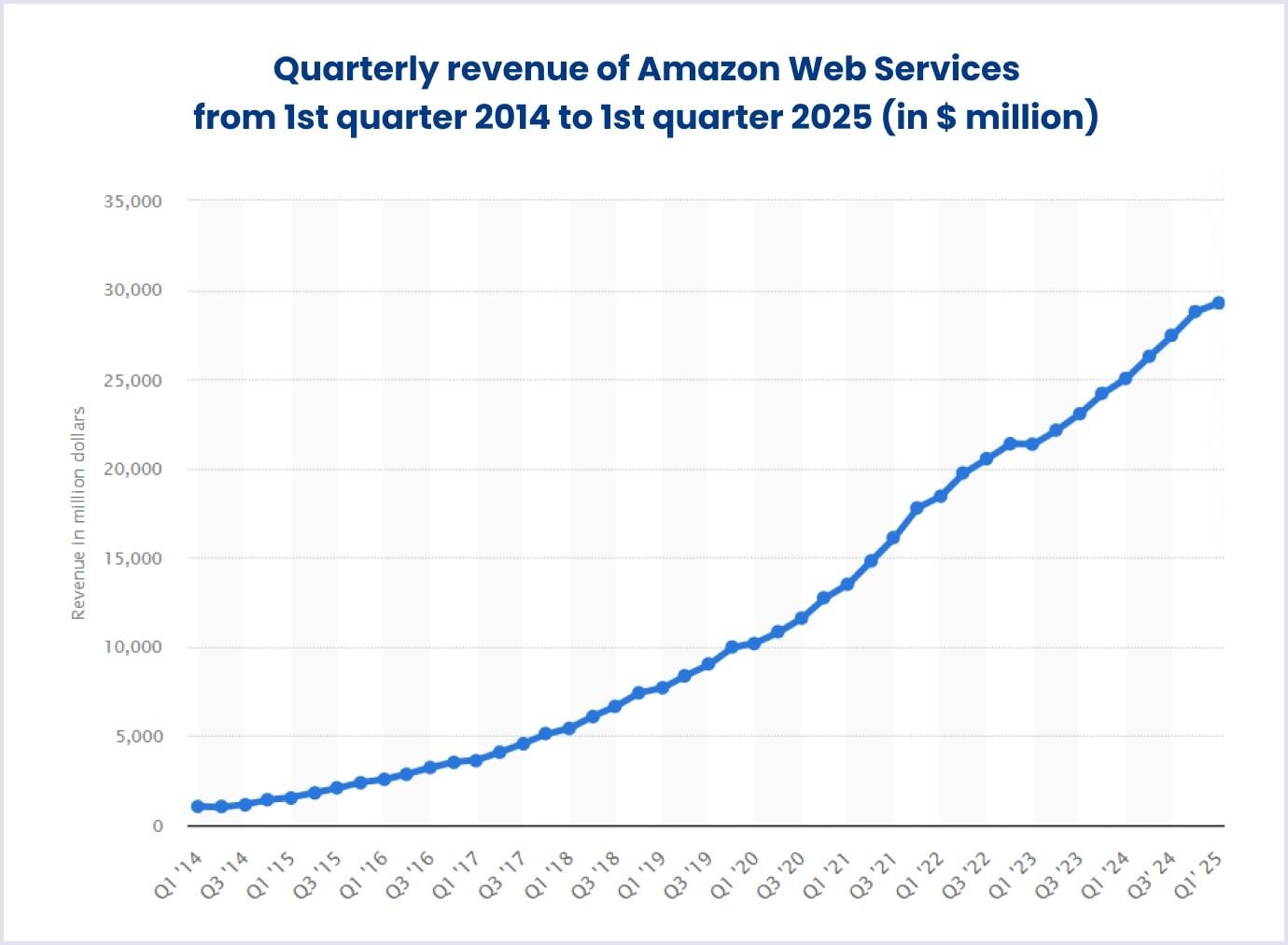
Source: Statista
Why is it worth building an ecommerce website?
Thanks to automated processes, opting for an online selling website provides various benefits. You can reach out to customers in different locations globally around the clock. With such audience growth, you can scale your marketplace startup and attract more sellers and buyers.
This, in turn, provides valuable data on your marketplace transactions, customer feedback, and behavior. You can use this data in your marketing strategy and planning features for your marketplace.
Moreover, an online platform simplifies shipping and delivery processes, making digital sales more cost-effective than offline ones.
As a result, you get a flexible sales resource that you can pivot according to customer, market, and digital changes.

Essential features for a marketplace like Amazon
To understand how to create a website like Amazon, let’s look at its core - the features. A multi-vendor marketplace covers sellers and buyers and manages processes with product listings, orders, shipping, delivery, returns, and refunds. Therefore, below, we discuss features as they work for both sides.
Amazon features for sellers
As a multi-vendor platform, Amazon offers comprehensive features for sellers. The functionality helps sellers manage sales from start to finish and make adjustments along the way. Currently sellers can manage these processes on the Amazon Seller Central dashboard.
Let’s see the core features that help sellers run their businesses on the Amazon product marketplace.
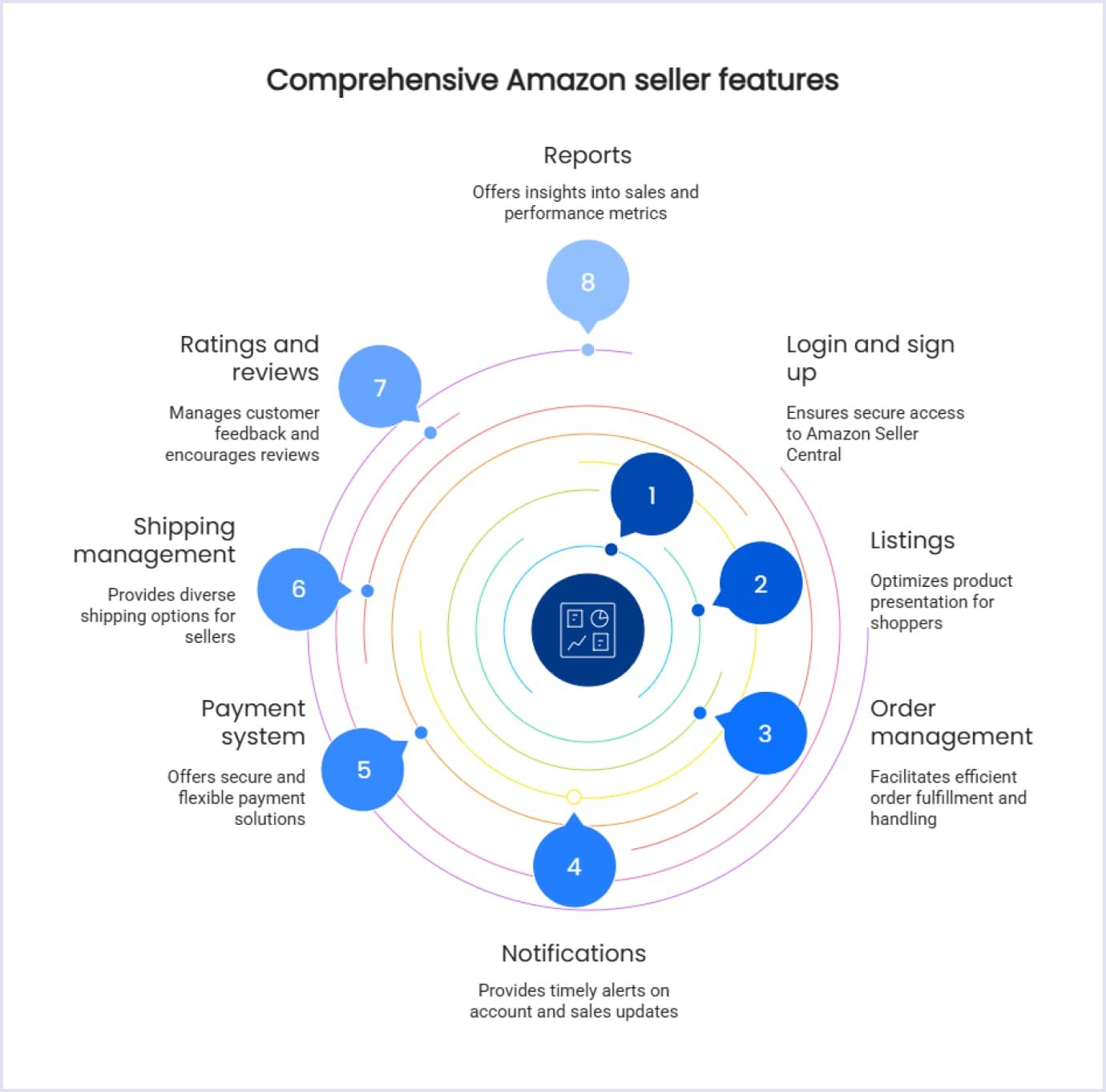
Login and sign up
Sellers must create an account to access the Amazon Seller Central dashboard. The process includes verification, ensuring sellers provide valid services and a safe shopping experience.
Listings
The sellers’ dashboard helps optimize listings to provide shoppers with the necessary information. Sellers can provide clear product descriptions, images, prices, and discounts. The product listings can also include details on shipping and delivery.
Moreover, Amazon introduced Generative AI to help sellers create product descriptions. You just need to provide a brief description of a product, and AI will generate the relevant content. A seller can refine the content if they wish or use it as it is.
Order management
Sellers can choose between two order fulfillment options: Fulfillment by Amazon (FBA) or Fulfillment by Merchant (FBM). If a seller chooses FBA, Amazon handles shipping and delivery. Otherwise, sellers partner with carriers to deliver products to shoppers.
The order management integration also allows sellers to update order statuses, respond to issues with shippers, and manage returns and refunds.
Notifications
Sellers can receive various notifications through the dashboard. The Amazon platform notifies sellers of account updates, listings, and tech aspects. Sellers also receive alerts on issues with listings, returns, and claims. Notifications also highlight messages from buyers.
Payment system
By providing flexibility and security in payment solutions, Amazon helps sellers improve turnover. The platform offers secure payment processing, simple integration, and fraud protection. The four essential options sellers can offer are payments with credit cards, digital wallets, in installments, Amazon Pay, and Buy Now, Pay Later service.
Shipping management
Amazon offers sellers several shipping options. Depending on their needs, sellers can select one of the options. For example, they can choose Amazon fulfillment centers, shipping from remote spots, shipping large items, and selecting from courier partners.
Ratings and reviews
As this aspect is crucial for sales, Amazon outlines how sellers can encourage and respond to reviews and manage negative feedback. The platform provides sellers with review management automation tools, helping get review alerts, analyze reviews, and interact with customers on positive and negative feedback.
Reports
Amazon seller reports include data on business, advertising, custom, and inventory reports. Thus, sellers get insights into sales, product views, conversion rates, ad performance, and return and fulfillment stats. This data helps sellers optimize their stock, order fulfillment processes, and interactions with shoppers.
Amazon features for buyers
Focusing on customer experience, Amazon provides helpful features to make buying as simple and smooth as possible. Let’s review Amazon features for buyers that will make your platform a delightful place to purchase.
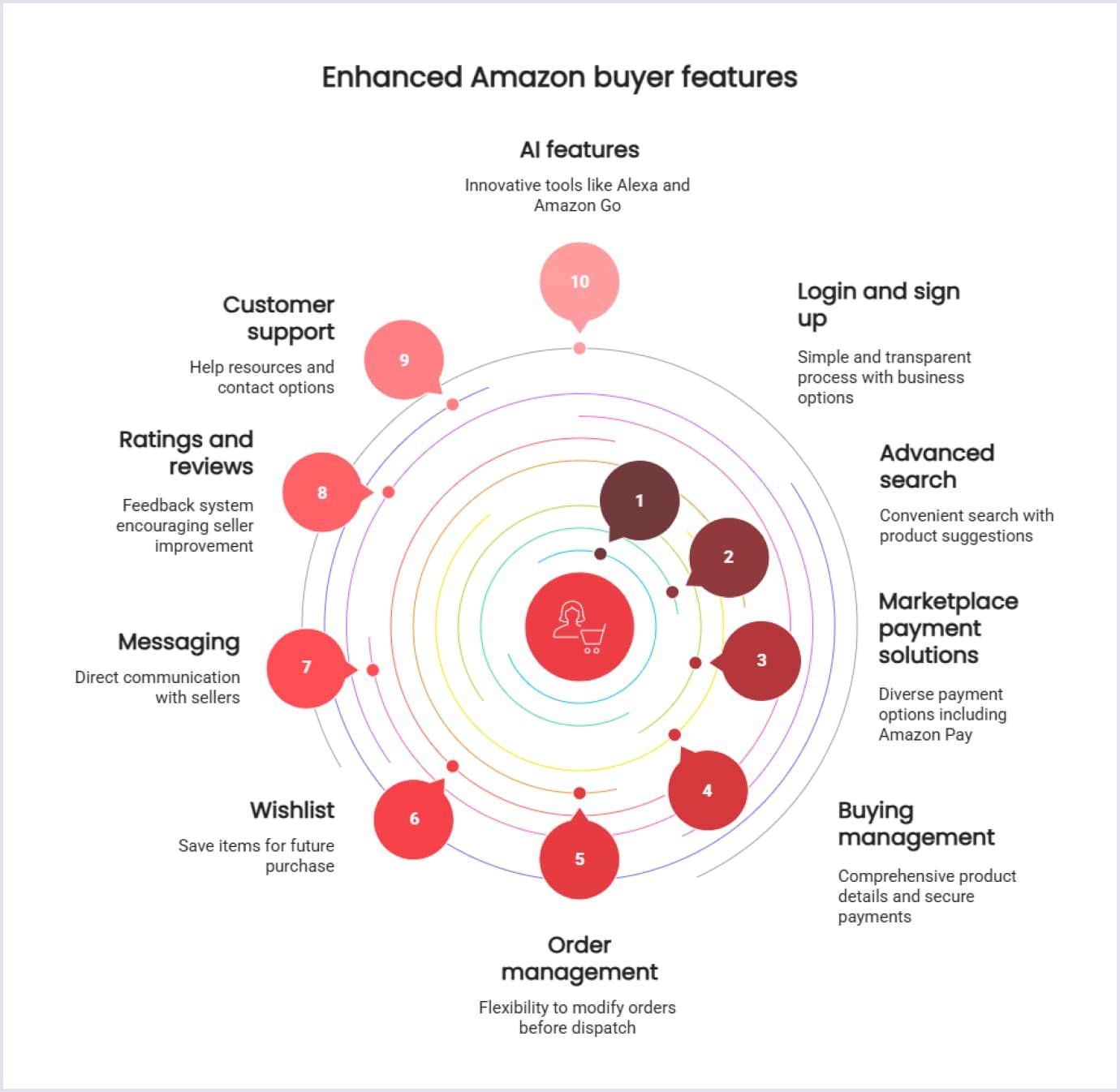
Login and sign up
Amazon’s login and signup process is simple and transparent. You only need to enter your name, email or mobile phone, and password. What’s also helpful is that Amazon offers free and premium registration for organizations with Amazon Business. Thus, organizations will buy office supplies, electronics, IT products, and other items with a simplified fulfillment process.
Advanced search
What makes searching on Amazon convenient is getting product options while you type search words. Thus, if you are unsure what you are looking for, you get the proper hints and quickly find what you are looking for.
Marketplace payment solutions
In addition to credit cards, shoppers can pay in installments and cash on delivery. Customers can also pay with Amazon gift cards, Amazon Business credit, Amazon Pay, and more.
For example, Amazon Pay provides helpful features for buyers to manage payments and returns. A buyer can view their orders and transactions and handle returns and refunds. Moreover, you can troubleshoot failed payments, resolve suspended orders, dispute transactions, and file complaints.
Buying management
When you buy products on Amazon, you can search, discover, and buy products. The company offers comprehensive product descriptions and images, secure payments, and flexible returns and refunds. As a buyer, you can also choose and manage delivery and shipping parameters and clear any questions with a seller when buying products.
Order management
The platform allows you to manage and change your orders if products have not been dispatched yet. So, a buyer can change the product quantity, billing address, delivery address, payment methods, and more in your order. The only limitation is that you need approval of cancellation from a seller if the shipping process has started.
Wishlist
If you have found several similar items or plan to buy something but are not ready for checkout, you can save those items to a wishlist. You can create several wishlists and add items from different categories.
Messaging
Buyers can message sellers to clarify details on products, orders, shipping, and delivery. Amazon helps with better communication by offering the option of attaching files and images. The messaging service protects against spam and phishing. Also, Amazon saves copies of correspondence to protect customers’ rights for claims.
Ratings and reviews
This feature enables shoppers to leave reviews on products that they bought. Ratings allow you to assess the product from one to five stars and leave feedback on the product page.
What’s remarkable about Amazon’s rating system is that the company encourages buyers to settle disagreements with sellers instead of leaving negative feedback. Surely, this does not limit buyers, but it helps sellers improve the quality of their products and services and increase their sales.
Customer support
Amazon provides help with reference materials on the frequent questions sellers have. For this, the platform highlights categories and searches across the help library. If the question does not fall into the suggested categories, you can request a phone call or contact help via chat.
AI features
- Interests AI feature. This feature allows buyers to choose products based on their interests, like golf, football, home decor, or others. The feature allows you to select products using natural language. You just type in your preferences, and the feature will continuously scan Amazon products for you and notify of possible matches.
- Enhanced Alexa. Thanks to advanced AI technologies, Alexa allows you to have long conversations without repeating yourself. Whenever you're unsure about a product or where to find it, Alexa will help you by responding to even extended prompts.
- Amazon Go. This technology allows you to take products and then automatically get charged only for the products you take. This way, Amazon improves customer experience by providing speed and convenience.
How to build a website like Amazon: key steps
Amazon offers various services for millions of users and processes many transactions and procedures daily. How is it possible that Amazon maintains those processes and provides users with convenient service? The answer is a thorough approach to development and support.
If you want to learn how to start a company like Amazon, read the steps below. It is a simplified explanation of the marketplace building process. Yet, it will help you understand the starting points so you can build a similar marketplace MVP.
Discovery phase
Research and planning are essential to ensure success in the following stages when building a marketplace like Amazon. Our product discovery sessions help you define your marketplace’s value, target audience, competition, features, architecture, and tech stack.
After thoroughly researching the above aspects, we will give you a timeline, cost estimates, and team composition recommendations. Depending on the features you want to include, we choose the technologies that will make your marketplace robust and secure.
Below is a video explaining the deliverables you get after the project discovery phase.
UX/UI design
Along with business and technical aspects, we provide clickable prototypes at the discovery stage. They help you see how your marketplace will work. Prototyping will enable you to change your ecommerce website design at the earliest stage.
After we agree on the prototypes, we will add colors, fonts, fields, buttons, and other visual elements. These will make your product recognizable and delightful to your sellers and buyers.
Our designers also compile design guidelines for the marketplace UI/UX to help developers choose suitable approaches to make a website like Amazon.
For example, at Codica, we helped create a visually appealing online travel marketplace for iExpedition with our UI/UX design services. Our task was to build a user-friendly and easy-to-manage booking system to help customers find the most suitable cruise. As a result, all the pages were designed correctly to make the platform convenient and appealing to users.

Marketplace MVP development
If you start a marketplace, test it with a minimum viable product development services. MVP is a version of your marketplace that includes essential features, bringing value to your customers.
As an online marketplace development team, we will help you build the core part so you will spend less time and money on it. As you include only the minimum marketable features, you spend fewer resources than with a fully-fledged product. Starting small means playing safe. Based on your customers’ feedback, you can scale your marketplace later.
Below is a tech stack we use to build a robust and secure marketplace like Amazon.
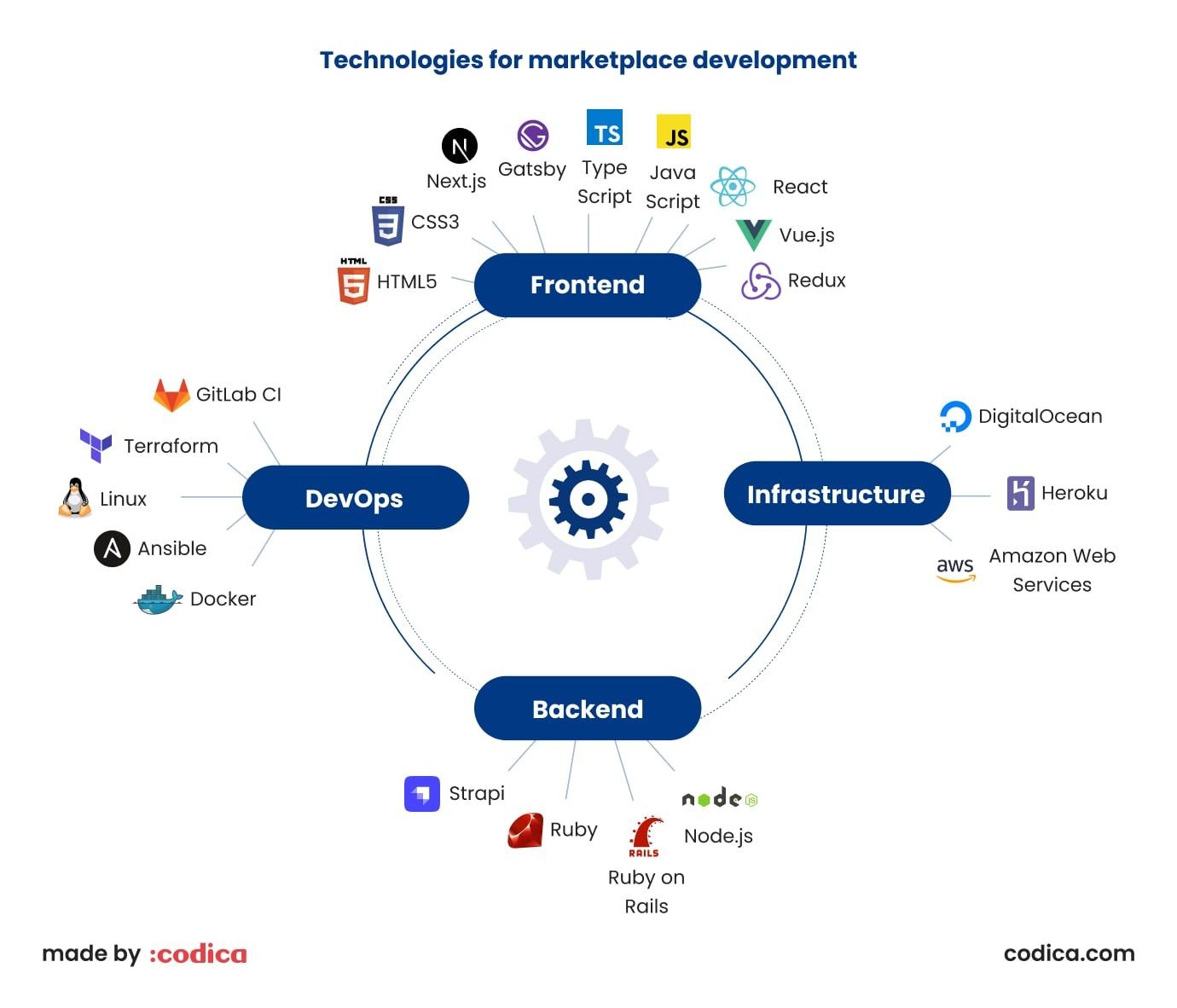
Quality assurance
As a marketplace like Amazon will scale over time, it is essential to ensure that it is robust and bug-free. We provide quality assurance services to verify your marketplace MVP using automated tests, ensuring that all components work properly, both individually and collectively.
Maintenance and support
As your marketplace scales, you will need updates based on customer feedback and changes in the market and technologies. That is why making timely patches and security updates based on the latest standards is essential.
Thanks to our DevOps services, your marketplace will be protected and work smoothly. DevOps engineers create a safe environment for your marketplace’s operation and monitor its security.

How much does it cost to build a website like Amazon?
To begin with, Amazon is a complex platform that has taken many years to evolve. However, let’s try to estimate the cost of creating a multi-vendor marketplace website like Amazon.
We should take into account the required functionality and the rates of the software development provider that will help build your marketplace website. These are the most significant aspects that will influence the required budget.
The table below shows the features cost for an Amazon-like marketplace MVP.
| How much does it cost to build a multi-vendor marketplace like Amazon? | ||
| Features | Time, hours | Cost ($50/h) |
| Design | ||
| UX development | 64 | $3,200 |
| UI development | 96 | $4,800 |
| Architecture | ||
| Project setup | 16 | $800 |
| DB structure | 32 | $1,600 |
| Integrations | ||
| Payment (Stripe or PayPal) | 64 | $3,200 |
| Shipment (Shippo) | 32 | $1,600 |
| Main functionality | ||
| Authorization and security | 72 | $3,600 |
| User profiles | 42 | $2,100 |
| Homepage | 64 | $3,200 |
| Search and filters | 72 | $3,600 |
| Product page | 42 | $2,100 |
| Reviews and ratings | 48 | $2,400 |
| Shopping cart | 64 | $3,200 |
| Notifications | 32 | $1,600 |
| Buyer panel | 120 | $6,000 |
| Vendor panel | 156 | $7,800 |
| Admin panel | 120 | $6,000 |
| Wishlist | 32 | $1,600 |
| Non-development activity | ||
| Project management | 64 | $3,200 |
| Quality assurance | 96 | $4,800 |
| Code review | 48 | $2,400 |
| Total | 1376 | $68,800 |
So, if you are wondering how much it costs to build a website like Amazon, our rough estimate is a minimum of $68,800. To calculate this number, we used the average hourly rate for Eastern European development agencies, which is $50/hour.
Opportunities and challenges for websites like Amazon
To build a website like Amazon, you must know the opportunities and risks of entering a global marketplace. Let’s see what they are in more detail.
Opportunities
First, let's look at the opportunities multi-seller marketplaces like Amazon can provide:
- Unlimited scalability
Online marketplaces can handle a large number of orders. Furthermore, such platforms help unite partner organizations and expand their range of products and services. This enables you to create new ways to generate income and find additional sales channels.
- High customer traffic
As your online marketplace spans beyond specific locations, you can reach a broad audience. This aspect attracts more sellers so that you can get Amazon’s marketplace sales opportunities.
Customer behavior and interactions with your marketplace website are also valuable data sources. Using the numbers, you can personalize customer experiences with your platform.
- Flexibility
Technologies provide you with solid opportunities to manage many processes simultaneously, including shipping, delivery, returns, and refunds. Artificial intelligence in ecommerce is handy for streamlining those processes. Swift and easy services delight your shoppers and buyers and help them reach their goals on your platform.
- Revenue
Marketplace owners have many monetization options, including fees, commissions, featured listings, subscriptions, and premium services for users. Thus, owners can choose the most appropriate way to generate money for their marketplace.
Common challenges
However, despite all the advantages, there is no absolutely perfect work strategy in ecommerce. Thus, here we highlight a few common problems you should be ready for when considering starting a horizontal marketplace like Amazon.
- High competition
Competing with giants like Amazon, eBay, and AliExpress is challenging. Nevertheless, examples of well-known marketplaces prove that success will come if you start a niche marketplace and then scale your business to more categories.
- The chicken and egg problem
When you set up your website at an early stage, you can face the chicken-and-egg problem. Obviously, you don't have sellers and buyers when you launch a marketplace. Therefore, you should convince one of the parties to come in first to your platform.
By the way, it was one of Amazon's website problems when it started as a multi-vendor marketplace. Amazon was a successful book retailer before it became a horizontal marketplace with a wide range of products. It solved the chicken and egg problem by using the same customer base from the earlier business. With a strong consumer base, Amazon allows other sellers to list their products on its platform.
- Logistics challenges
As marketplaces like Amazon operate globally, you need tools to align shipments between different geographies. You will also have to align logistics processes to prevent delivery delays.
- Pricing options
Sellers might be puzzled about setting prices for their products, as similar offers are all over the platform. That is why you can use dynamic pricing algorithms, adjust pricing tiers, and monitor pricing strategies. These methods will optimize pricing for sellers and buyers.
- Varying targets
As Amazon embraces various product categories, it covers different audiences and loses niche focus. Being horizontal companies, they should develop marketing strategies focused on particular target groups.
Why turn to Codica for multi-vendor marketplace development
As a multi-vendor marketplace development company, we have extensive experience in marketplace website development. We have successfully launched many ecommerce websites that bring high traffic, increase conversion, and boost sales.
For example, we helped build the first online auto marketplace in Africa. The client asked us to build an online multi-vendor marketplace platform where users could sell or buy vehicles. So, our task was to make the website convenient, with a high loading speed, simple workflow, and optimization for mobile devices.
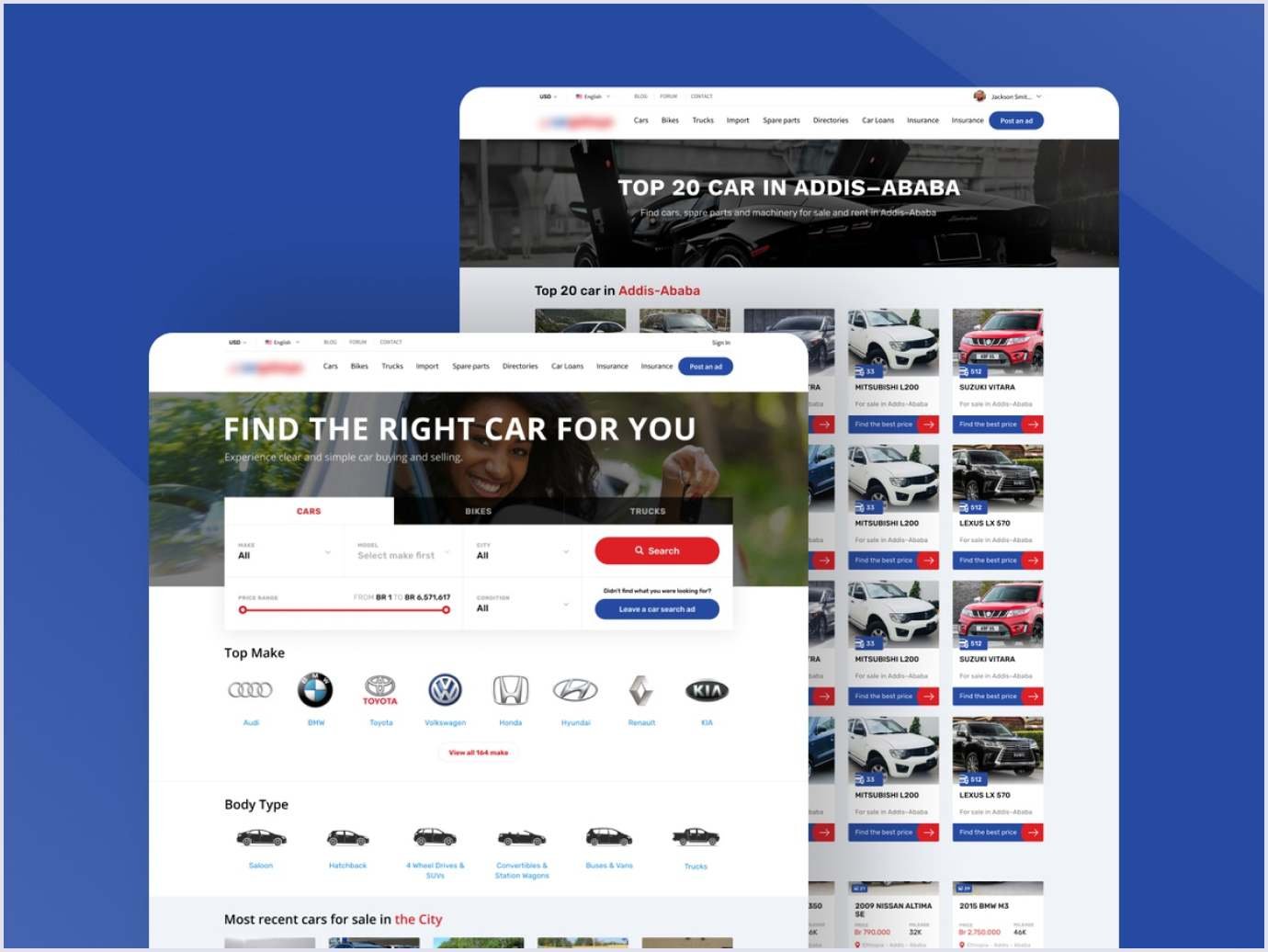
As a result, we created a user-friendly multi-seller marketplace that is convenient for both buyers and vendors. Therefore, our client could successfully present the first version of the product to investors.
You can also get acquainted with other examples of the projects that our team delivered in our portfolio.
Summing up
Amazon is a perfect example of a successful ecommerce website. It has transformed from a narrow book-selling platform into a complex and highly visited marketplace in the US over 30 years.
If you want to build an ecommerce website like Amazon, we are eager to help you create an engaging and thriving marketplace. Feel free to contact us. We will consult you on your marketplace project and give you a free quote.

